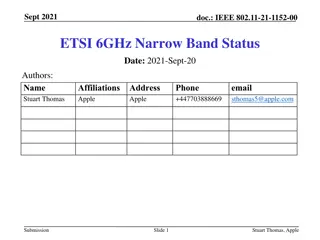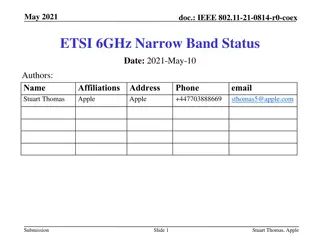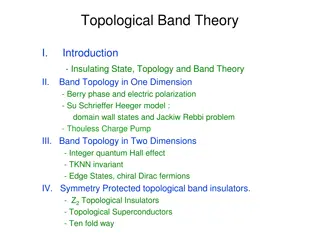Understanding Band Population in Semiconductors
Exploring the concepts of electron and hole population in semiconductor bands through the Fermi-Dirac function, density of states, and Fermi energy. Learn how the Fermi function influences carrier concentration, the difference between metals and semiconductors in band structure, and the behavior of electrons and holes at various energy levels based on temperature conditions.
Uploaded on Sep 14, 2024 | 0 Views
Download Presentation

Please find below an Image/Link to download the presentation.
The content on the website is provided AS IS for your information and personal use only. It may not be sold, licensed, or shared on other websites without obtaining consent from the author. Download presentation by click this link. If you encounter any issues during the download, it is possible that the publisher has removed the file from their server.
E N D
Presentation Transcript
Lecture 6 Density of States , Fermi-Dirac Function and Charge carriers
Recap Electron and hole concentration has been calculated at thermal equilibrium and their product is calculated. N (E) is proportional to E1/2 so the density of states in conduction band increases with electron energy. Fermi function becomes extremely small for large energies. Electrons are accumulated at the bottom of the conduction band edge and holes are accumulated at the top of the valence band.
How do electrons and holes populate the bands? 1 Ef Fermi energy (average energy in the crystal) k Boltzmann constant (k=8.617 10-5eV/K) T Temperature in Kelvin (K) = = f E ( ) E E kT ( / ) + + e 1 f f(E) is the probability that a state at energyE is occupied. 1-f(E) is the probability that a state at energy E is unoccupied. Fermi function applies only under equilibrium conditions, however, is universal in the sense that it applies with all materials-insulators, semiconductors, and metals.
Metals vs. Semiconductors Allowed electronic-energy states g(E) or N (E ) The Fermi level Ef is at an intermediate energy between that of the conduction band edge and that of the valence band edge. Fermi level Ef immersed in the continuum of allowed states. Ef Ef Metal Semiconductor
How do electrons and holes populate the bands? Fermi function and Carrier Concentration Note that although the Fermi function has a finite value in the gap, there is no electron population at those energies. (that's what you mean by a gap) The population depends upon the product of the Fermi function and the electron density of states. So in the gap there are no electrons because the density of states is zero. In the conduction band at 0K, there are no electrons even though there are plenty of available states, but the Fermi function is zero. At high temperatures, both the density of states and the Fermi function have finite values in the conduction band, so there is a finite conducting population.
Intrinsic, n-Type, p-Type Semiconductors Energy band diagrams CB Ec Ec Ec Ef n Ef i Ef p Ev Ev VB Ev (c) p-type (a) intrinsic (b) n-type n0p0= ni2
How do Electrons and Holes Populate the Bands? Density of States Concept gc The number of conduction band states/cm3 lying in the energy range between E and E + dE .(if E Ec). dE E gv ) ( E dE ( ) The number of valence band states/cm3 lying in the energy range between E and E + dE (if E Ev). Density of states in conduction band increases in upward direction as a function of square root of energy while density of states in valence downward direction as a function of square root of energy . General energy dependence of gc (E) and gv (E) near the band edges. band increases in
How do electrons and holes populate the bands? Typical band structures of Semiconductor g(E) (E Ec)1/2 E E E Ec+ [1 f(E)] CB For electrons = = = = Area nE E dE n ( ) nE(E) Ec Ec number of states per unit energy per unit volume number of electrons per unit energy per unit volume The area under nE(E) vs. E is the electron concentration. probability of occupancy of a state EF EF Ev pE(E) Ev Area = p For holes VB 0 fE) nE(E) or pE(E) g(E) X f(E) g(E) Energy band diagram Density of states Fermi-Dirac probability function Energy density of electrons in the CB
Pure-crystal energy-band diagram In an intrinsic semiconductor, n = p. So there are equal number of states in equal-sized energy bands at the edges of the conduction and valence bands, n=p implies that there is an equal chance of finding an electron at the conduction band edge as there is of finding a hole at the valence band edge : f(EC) = 1 f(EV)
n-type material For an n-typesemiconductor, there are more electrons in the conduction band than there are holes in the valence band. This also implies that the probability of finding an electron near the conduction band edge is larger than the probability of finding a hole at the valence band edge. Therefore, the Fermi level is closer to the conduction band in an n-type semiconductor:
p-type material For a p-type semiconductor, there are more holes in the valence band than there are electrons in the conduction band. This also implies that the probability of finding an electron near the conduction band edge is smaller than the probability of finding a hole at the valence band edge. Therefore, the Fermi level is closer to the valence band in an p-type semiconductor
Summary Density of states in conduction band increases in upward direction as a function of square root of energy while density of states in valence band increases in downward direction as a function of square root of energy . Electrons accumulate at the edge of the conduction band in case of n-type semiconductor and showing more concentration of electron than holes and in case of p-type semiconductor holes accumulated at top edge of the valence band showing more concentration of holes . Distribution functions are nothing but the probability density functions used to describe the probability with which a particular particle can occupy a particular energy level. In n-type Fermi-Dirac function exaggerated towards conduction band above Ec and in case of p-type it is exaggerated to valence band below Ev.















